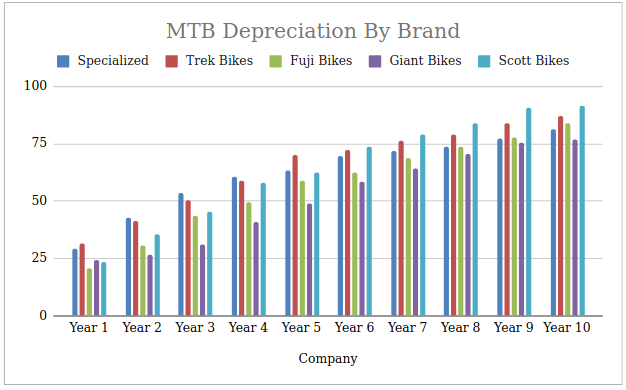At some point in your biking journey you may start to wonder how long do mountain bike last, what’s the average age and how can I extent the life of my mountain bike.
Mountain biking has many health benefits, starting with improving cardiovascular fitness, strengthening your immune system, reduced stress and improved mood, and enhancing balance and coordination.
But, before you hop on your bike, you need to know whether it’s worth it? How long will it last and what value you can expect of your mountain bike when you sell it.
Designed to perform exceptionally on steep descents while being nimble & light enough for pedal uphill, a mountain bike has to face more than the stress and forces of the mother nature.
From what I have learned, experience and find online, a mountain bike last somewhere between 16 to 20 years if its maintained well or can be worthless in less than 5 if poorly maintained.
However, this article’s agenda is to answer the queries of most people who are planning to purchase a mountain bike for the first time; these include what is the lifespan of a mountain bike, what factors influence it, and tips to keep your bike looking new. So, scroll down and find out:-
How Long Does a Mountain Bike Last?
Well, there’s no one-word answer to how long a mountain bike lasts, but with good maintenance, your bike can function optimally for up to 20 years.
The lifespan mainly depends on how much and where you ride. Some items such as tires, chains, drivetrains, and brake pads wear out in the first few years.
Therefore they need to be replaced right away to make your bike last longer. So, in a nutshell, careful maintenance holds the key when it comes to longevity.
If you keep your bike out in the open, even during the rainy season, without a dilemma, the chain is going to get rusted. Always check the pressure of the tires before you begin your trial journey.
Ensure that you lube the chain regularly, wide down the chain so that the lube doesn’t reach the braking system. And, finally, clean them after every trip for dirt or moisture.
In this next segment, we’ll be putting forth fundamental factors that affect the mountain bike’s lifespan, so read on.
Factors That Impact Mountain Bike Life Span
Here are factors, if taken care of, will ensure a healthier and longer-lasting mountain bike:-

1. Maintenance
Like said earlier, proper maintenance is imperative to ensure that the bike is healthy for a long-haul. Yes, mountain bikes are designed to get dirty easily.
But, if you let the dirt settle on for a longer duration will cause the different components of the bike to wear and tear prematurely. So, you have to wash your bike thoroughly regularly.
Don’t go for the power wash; use a gentle car wash soap and a brush to clean all the difficult-to-reach crevices, where the dirt easily piles up. Buy a drivetrain cleaner to get rid of the chain’s dirt & grime.
2. Never Grind Your Gears & Strain Your Chain
Shifting the gear of a mountain bike on trial is more science than art. If you cannot shift your bike to a lower gear as you ride uphill, a lot of pressure will put on the drivetrain, making horrible noises.
This could cause significant, long-term damage to the bike’s various components, including the chain, chainring, & cassette. You need to quickly anticipate the shift and do it properly rather than pedaling hard. When and how you shift the gear will affect your drivetrain’s life.
3. Give Your Brakes a Break
The brakes are the essential component that often falls out if you don’t treat them right away. If you mash down on your brakes or bomb into corners, it will not last for long.
Make sure you brake gently as you reach the corner, and learn how to roll the bike through the corners with no brakes. It will help improve your bike’s speed, and your brake pads will last a lot longer.
Also, it is highly advisable to avoid using the rear brake. For the front brake, make sure you push it in a controlled manner and will allow you to help with the corner.
Besides, feather your brakes for reducing them gradually, rather than mashing down on them quickly.
4. Don’t Neglect Your Mountain Bike Suspension
Once the mountain bike’s sag is set, many riders don’t think much about the suspension; this is a big mistake. Over time, the grime & dirt get onto the fork stanchions after every ride; if you avoid it, it could cause problems. The air pressure in time will slowly decrease.
If you aren’t checking the pressure regularly, you will risk sustaining significant damage when the suspension is bottom out after a big hit.
The fluid inside the shock and the fork must be changed periodically, just like the engine oil.
If you don’t rebuild your suspension as required, you might need to buy a whole new shock or fork; if you neglect it in the first place. So do not neglect your bike or its parts!
5. Keep Your Tires Under Pressure
Squeeze your tires now and then to ensure they feel firm? Wrong, the squeeze method isn’t the right method to measure the tire’s pressure.
Get a digital tire pressure gauge and check the pressure once a week.
Ensure that you keep track of the pressure; if you ride without proper tire pressure, you will run the risk of sustaining pinch flats. What’s worse, you’ll break the rim.
Value Your Mountain Bike Lose Per Year
We know that mountain bikes are way more pricey than conventional bikes, but its second-market is struggling because of high depreciation.
The bikes can expect to lose money as soon as set on their first trail trip. Your mountain bike will ridiculously lose its value in one year, 25.9% for one year.
The description value of a mountain bike is much greater than your car. Coming to the second year, the depreciation value is 35.4%.
If you plan to sell off your bike after two years, you can expect to lose its value by 1/3rd. After three years of use, the depreciation is 44.9%, and by the tenth year, the mountain bile will lose its value by 84.9%.
So, if your bike is running in top condition, then avoid selling it rather than keep it with you or gift it to your friend, even when you buy a new mountain bike.
However, the actual selling cost depends upon the condition of your bike, both its aesthetic appeal and its functioning. Before selling your bike, take it for a service, replace the parts not functioning along with the tires that make your bike look better adding to its resale value.
How To Keep Your Mountain Bike Like New
Here are tips to keep your mountain brand-new:-
Keep Your Tires Inflated Properly
Maintaining a good bike tire pressure is important as you’re always wanting the best performance from your bike. The tires which are not inflated appropriately are prone to punctures and damage.
Check the pressure given on the tire side for optimal pressure range. Too much air in your tires can lead to balance issues but helps in speed, while a lower pressure creates more resistance, but also helps grip the road. So a compromise should be made, and a psi of around 25 to 50 be maintained for mountain bikes.
Check Your Brake Pads
You can easily tell if the brake pads have worn out if grooves are not visible. Fitting new brake pads is expensive but considerably improves the biking experience.
Get A Professional Service
The best way to keep your bike like new ( especially if you want the best performance from your bicycle ) is to give it a proper tune-up at your local bike shop.
Once or twice a year should be fine, ideally at the start of the spring season, if you plan tough winter tours ahead. This will helps maintain the level of comfort, performance, and maneuverability.
Lubrication
Be it your car or a mountain bike; regular lubrication is an important aspect of overall maintenance. Some brands need specific lubricants, so check the bike manual again.
The lubricant must be spread carefully on parts where the metal touches the metal. There is no need for oiling your chain unless you haven’t cleaned out properly, as this will even make the matter worse.
Check If the Wheel is True
Turn your mountain bike upside down, and then spin the wheels. If the wobble is moving side-to-side, then truing is needed. It is a quick fix, but not for the amateur; hire a professional with the right equipment.
Tighten Saggy Brakes
Your mountain bike’s brakes have become lackluster or sluggish. To better understand, if you squeeze the brake lever, it moves much freely towards the handlebars; then, you need to tighten the brakes.
Twiddle the barrel adjuster to tighten them up.
When Should You Replace Your Mountain Bike
Several warning signs tell you to need to buy a new mountain bike. These include the parts of the tough parties to find or repair now and then are burning a hole in your pocket.
Another reason to replace your old mountain bike is when its frame has been compromised, and replacing a frame is not feasible, as it is quite expensive.
But from my own experience biking, there are a few tell-tell signs it’s time you should replace your mountain bike. The easiest of all is the comfort and feel, look whether you outgrow your bike both in size and weight.
Then there are things to look like the signs for damages if any or simply you should consider to resale if you start to find it harder and harder to get replacement parts for your bike.
The last but not the least your taste for mountain biking has evolved over the years.
Wrapping it Up!
In the end, I hope you liked the article; we explained everything you need to know about the lifespan of your mountain bike, after factors affecting it, tips to make your bike running & looking like new, and the depreciation graph. From the above, maintenance is vital to keep your bike healthy for a long-haul.
Do you anything to add to this from your personal experience, do share it with us in the comment section below- we’d love to hear from you.
Also Read,
Do Mountain Bikes Holds Their Value? MTB Depreciation Guide










Leave a Reply